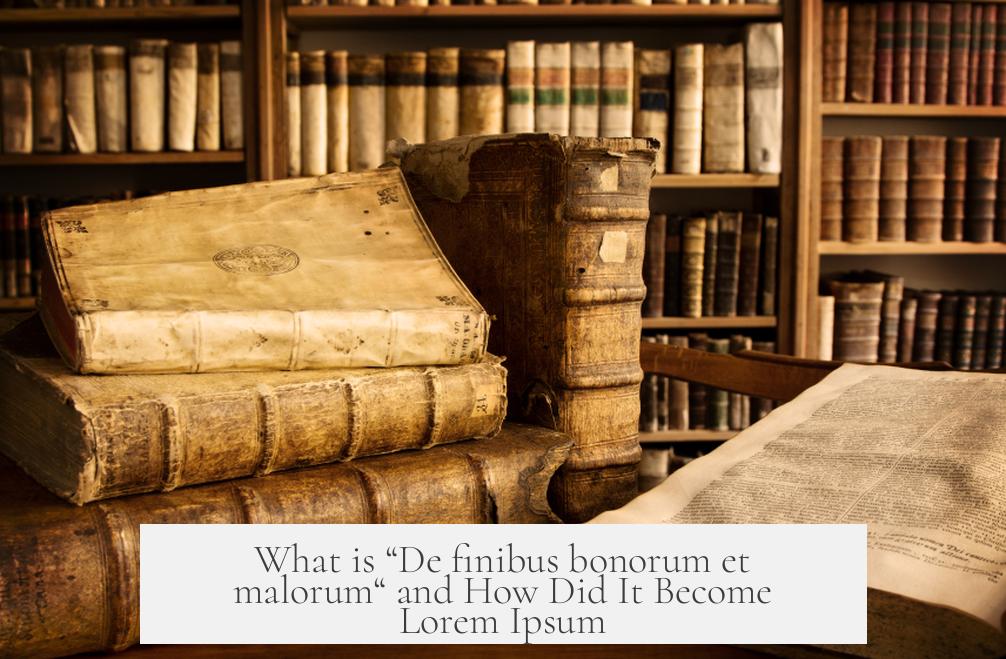“De finibus bonorum et malorum” is a philosophical work by Cicero written around 45 BC. It explores the ultimate goals of good and evil through dialogues on major philosophies of the time: Platonism, Stoicism, and Epicureanism. This Latin text is the source behind the scrambled typeset filler known as Lorem Ipsum.
“De finibus bonorum et malorum” translates as “On the Ends of Good and Evil.” The title breaks down as finibus (ends or limits), bonorum (of good things), and malorum (of evil things). Cicero’s work discusses key ethical considerations and contrasts these philosophical views. It was widely studied and preserved, though its connection to modern text samples was not known until centuries later.
In the 1980s, Richard McClintock, a professor at Hampden-Sydney College, uncovered the link between Cicero’s text and Lorem Ipsum. Searching for a rare Latin word in common Lorem Ipsum samples, he traced it back to a passage in Cicero’s work. This discovery revealed that the filler text comes from a legitimate Latin source, though heavily altered.
According to McClintock’s theory, the Lorem Ipsum text originated with a typesetter in the 1500s. This individual deliberately scrambled sections of Cicero’s work to create a nonsensical filler. The aim was to use authentic Latin but avoid meaningful sentences, thus enabling a focus on typography and layout rather than content. The typesetter mixed and cut text so readers would concentrate on the page design.
This practice makes sense within the printing and typesetting trades. When showing layout samples, distractions from meaningful content could detract from evaluating font size, spacing, and format. Lorem Ipsum became the standard because it offers natural word length variation and structure typical of Latin, yet avoids familiar meaning to casual readers.
The name “Lorem Ipsum” itself derives from traditional Latin document naming conventions using incipits—phrases from the beginning of a text. In the 1914 Loeb Classical Library edition of Cicero’s work, a hyphenated phrase including “dolorem ipsum” appeared at a page break. This phrase eventually evolved into the recognizable starting words of Lorem Ipsum filler.
Lorem Ipsum transitioned into modern usage primarily through graphic design. As printing advanced, Letraset, a manufacturer of dry-transfer letters, popularized the text in the mid-20th century for mockup layouts. Designers used it to avoid distracting viewers with actual readable content. When digital typesetting and desktop publishing software emerged, Lorem Ipsum was integrated as the default placeholder text in many programs.
The choice of Latin for filler text offers specific benefits. Latin is largely unfamiliar to modern readers outside academia, law, or medicine. This obscurity keeps the reader’s focus away from meaning and on the visual design. The centuries-old tradition persists because humans tend to get distracted by readable content. Lorem Ipsum continues to solve that problem efficiently.
| Aspect | Details |
|---|---|
| Origin | “De finibus bonorum et malorum” by Cicero (~45 BC) |
| Connection to Lorem Ipsum | Discovered by Richard McClintock in 1980s |
| Typesetting Use | Scrambled excerpts for layout focus, 1500s |
| First Popularization | Letraset sheets in mid-1900s graphic design |
| Adoption in Software | Default filler text in desktop publishing |
| Reason for Latin | Unfamiliar language minimizes reader distraction |
Lorem Ipsum is not merely random gibberish; it traces back to a respected philosophical text. Designers rely on it because it mimics natural word patterns without meaningful content, making it ideal to test visual design. The practice of using scrambled Cicero text as filler has lasted for over 500 years due to its practical effectiveness.
- “De finibus bonorum et malorum” is Cicero’s philosophical text on good and evil.
- Richard McClintock linked Lorem Ipsum to Cicero’s work in the 1980s.
- A 1500s typesetter scrambled the Latin text to create nonsensical filler.
- The phrase “Lorem Ipsum” derives from Latin incipits in traditional texts.
- Designers adopted it in the 20th century to highlight layout without distraction.
- Modern software continues to use Lorem Ipsum as default placeholder text.
What is “De finibus bonorum et malorum“ and How Did It Become Lorem Ipsum?

Simply put, De finibus bonorum et malorum is an ancient philosophical work by Cicero that inadvertently became the source for the classic placeholder text we all know as Lorem Ipsum. But let’s not stop there—this story delves into centuries of philosophy, printing history, and graphic design tradition. Curious? Let’s unravel it.
First things first: De finibus bonorum et malorum translates from Latin as “On the Ends of Good and Evil.” Written by Cicero around 45 BC, it’s a series of dialogues exploring the major philosophies of the time—Platonism, Stoicism, and Epicureanism. These aren’t bedtime stories but deep meditations on morality and ethics. Why does that matter? Because from such erudite debates came the text that now fills the empty spaces of modern layouts.
Cicero was no fleeting voice in antiquity. His influence stretches across millennia. Take the Founding Fathers of the United States, for example. Thomas Jefferson, in a May 1825 letter to Henry Lee, named Cicero among the authors grounding public law. John Adams even remarked that reading Cicero contributed “much to Health.” One could argue Cicero’s philosophical brand had better marketing longevity than most authors today—Agatha Christie level longevity, perhaps.
The Eureka Moment: How Cicero’s Text Became Lorem Ipsum
Fast forward to the 1980s. Professor Richard McClintock of Hampden-Sydney College in Virginia had an intriguing question: Where did this odd Latin filler text, Lorem Ipsum, originate? He hunted for a rare Latin word present in Lorem Ipsum—”consectetur”—and found it in Cicero’s De finibus bonorum et malorum. This was his Eureka moment.
McClintock theorized that a clever typesetter in the 1500s took a passage from Cicero but scrambled it intentionally. Why? To create a block of text that mimics natural language without the distraction of meaningful content. Imagine a man showcasing wires of different lengths; if he gestured toward a spaceship in the background, your attention might wander. Similarly, readable text can pull focus from the design at hand.
Why “Lorem Ipsum”? The Name and Its Roots

The phrase “Lorem Ipsum” is a classic example of an incipit—a Latin tradition of naming documents by their opening words. In the 1914 Loeb Classical Library edition of Cicero’s work, a break happened on a page where the text jumped to the next page. The hyphenated word “dolorem ipsum” appeared at the top. Earlier editions also had similar breaks, embedding “Lorem Ipsum” unintentionally into print history.
This quirky accident set the stage for “Lorem Ipsum” as the go-to dummy text over centuries.
From Ancient Scrolls to Modern Screens: Transition to Graphic Design
In the mid-20th century, graphic designers needed standard text to test layouts without distraction. Lorem Ipsum filled that slot perfectly. Letraset sheets featured it, allowing designers to cut and paste text onto visuals to depict where real words would go.
When computers entered the scene, software integrated Lorem Ipsum as a default placeholder. This tradition stuck not by chance but because Latin, being largely unreadable to most outside specific professions, keeps readers from getting sidetracked by content. Designers want the eyes on the format and style, not on what the text says.
Think about it: despite centuries, human curiosity remains stubborn. Designers cleverly exploit this by using Latin to keep our attention cliff-diving into visual elements rather than the written words that would otherwise steal the spotlight.
Why Should We Care About Lorem Ipsum’s Origins?

Beyond being a quirky filler, Lorem Ipsum connects us to a philosophical heritage. It reminds us that even the most mundane tools—like placeholder text—have rich histories and purposes. Knowing it comes from debates on good and evil adds unexpected depth to routine tasks like website design or book publishing.
Moreover, understanding this evolution showcases human ingenuity. From Cicero’s intellectual pursuits to a typesetter’s clever trick, and finally to computer programmers’ adoption, Lorem Ipsum bridges thousands of years of knowledge and practice.
Practical Tips for Designers and Writers
- Use Lorem Ipsum wisely: It serves best to focus on layout, spacing, and font without distraction.
- Know your audience: If presenting to clients unfamiliar with Latin, explain Lorem Ipsum’s purpose to avoid confusion.
- Consider alternatives: Some modern tools offer more “natural” filler text, but none have the historical charm or clean distraction-free quality of Lorem Ipsum.
- Embrace the story: Sharing the fun historical tidbit can make your projects more engaging and memorable.
Final Word
So next time you see Lorem Ipsum peppering a design template, remember—it’s not just gibberish. It’s centuries of philosophy, printing mastery, and purposeful craft wrapped into a few fragmented Latin words. A wise typesetter long ago knew human nature better than we give ourselves credit for. And thanks to scholars like Richard McClintock, we can enjoy this small but fascinating blend of history and design tradition.
Isn’t it amazing how a deep philosophical text about good and evil morphed into a universal tool for staying focused on what truly matters—the presentation?




